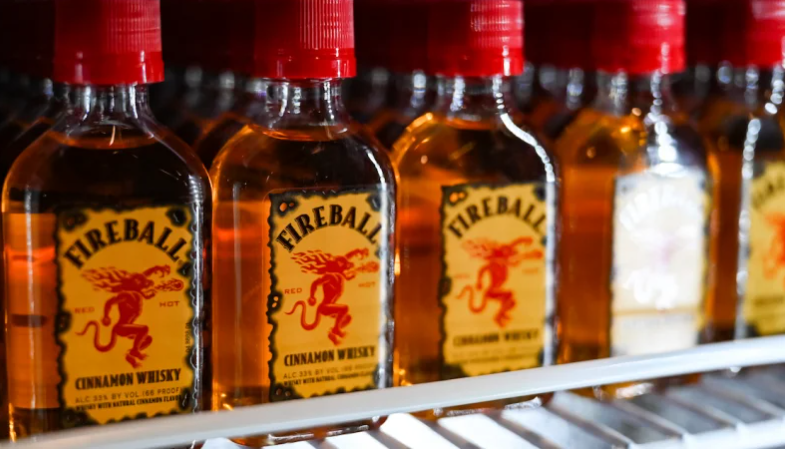Enter the intense legal dispute around Fireball Cinnamon Whisky! Imagine this: Convenience shops & petrol stations have 99-cent small bottles on their shelves that entice you with the promise of that comforting Fireball taste. But wait, are you really receiving a shot of whiskey, or is the famous red wax seal hiding a spicy secret? The Sazerac Company, the company that makes Fireball, was targeted in January 2023 by a hotly contested class-action lawsuit. The charge?
Deceptive marketing methods around the pocket-sized Fireball Cinnamon bottles. Come explore the complexities of this court drama as we follow the Fireball Cinnamon Whisky Lawsuit, the defendant’s assertions of clarity, & the unanswered question of what’s really within those blazing miniatures. Prepare yourself for an adventure through legal nuances, branding difficulties, & the conflict between customer expectations & product realities.
Overview of Fireball Cinnamon Whisky Lawsuit
Image credit – NBC Chicago
The present matter concerns a class-action lawsuit that the producers of Fireball Cinnamon Whisky are facing because of claims that they engaged in misleading marketing activities. The little bottles of Fireball Cinnamon that are sold at convenience shops & petrol stations are the main subject of this legal case. Unlike what consumers may think, these little pieces are
allegedly made not of whiskey at all, but rather malt or wine, then spiced with cinnamon to resemble the distinctive flavor of the classic whisky-infused kind.
According to the complainant, Anna Marquez, the packaging of the smaller bottles purposefully mimics that of the bigger whiskey version by using the same colors, typefaces, & even the recognizable red wax seal. Marquez claims that this purported replication tricks naïve consumers into thinking they are getting a shot of whiskey when, in fact, they are getting a flavored malt beverage with a far lower alcohol concentration.
The complaint raises issues about possible regulatory ramifications in addition to branding problems. Since whisky is a unique kind of alcoholic beverage, it must comply with certain regulatory regulations & is often taxed differently than malt drinks. The contention is that offering a comparable product for sale under the Fireball name might give rise to unfair benefits from the brand’s recognition & perhaps avoid certain legal restrictions.
In response to these accusations, Fireball’s owner, The Sazerac Company, argues that the labeling on the small bottles makes it obvious that they are “Fireball Cinnamon” bottles rather than “Fireball Cinnamon Whisky.” They argue that the beverage should be made clear to customers about its differences from conventional whiskey by virtue of its reduced price point & unique alcohol level.
Truth Behind Fireball Cinnamon Whisky Lawsuit
Image credit – USA Today
The Sazerac Company, the manufacturer of Fireball Cinnamon Whisky, is at the center of the complaint that surfaced in January 2023. It concerns their purportedly dishonest marketing tactics with reference to the well-liked 99-cent tiny bottles of Fireball Cinnamon. In contrast to Fireball Cinnamon Whisky Lawsuit, these small Fireballs are reported to be made from malt or wine & spiced with cinnamon in order to simulate the unique flavor of the legendary spirit, without actually containing any whiskey.
Although the complaint claims that the apparent similarity in packaging & branding causes customers to assume they are getting a tiny version of the actual whiskey, such a manufacturing procedure may be permissible under law.
One of the main players in the legal battle, Anna Marquez, claims she was duped by the Fireball Cinnamon label on these little bottles. Her defense centers on how very similar it looks to the bigger whisky version—it has the same colors, typefaces, & even the recognizable red wax stamp.
Marquez claims that this degree of imitation fools unwary consumers into believing they are purchasing a shot of whiskey when, in reality, what they are getting is a flavor-infused malt beverage with a far lower alcohol content.
The case explores issues of taxes & legal responsibilities beyond simple aesthetic considerations. Compared to malt drinks, whisky is a unique alcoholic beverage that often has various tax rates & regulatory requirements. A few detractors contend that offering a comparable product under the Fireball name might unjustly capitalize on the popularity of the whiskey brand & perhaps get under certain laws.
The Sazerac Company has responded to the charges by arguing that the tiny bottles’ labeling clearly identifies them as “Fireball Cinnamon” & not “Fireball Cinnamon Whisky.” They contend that the tiny bottles’ reduced price & unique alcohol level ought to alert customers to the product’s distinctions from regular whiskey. Although the lawsuit is still pending & may not have a clear conclusion, it has already spurred conversations about how the alcohol industry’s marketing, customer expectations, & regulatory compliance connect.
Current Status of Fireball Cinnamon Whisky Lawsuit
As of January, 2024 there was no information accessible to the public that indicated a settlement or noteworthy developments in the class-action lawsuit against Sazerac Company, the company that makes Fireball Cinnamon Whisky. The conflict dates back to January 2023 & centers on claims of misleading advertising tactics in relation to the sale of small Fireball Cinnamon bottles that are allegedly empty of whiskey.
Plaintiff Anna Marquez contends that the packaging deceived her, perhaps giving customers the impression that they are buying a tiny version of the real whiskey since it resembles the bigger liquor version. The argument put out by Sazerac stresses that the tiny bottles are labeled “Fireball Cinnamon” rather than “Fireball Cinnamon Whisky,” & that the product’s lower price point & unique alcohol level serve as differentiators. There are no significant advances in the judicial processes or signs of a resolution in the public domain while the matter is still pending.
Conclusion
Even when our tour through the intense legal proceedings surrounding the Fireball Cinnamon Whisky lawsuit comes to an end, there are still a lot of unanswered concerns. We’re on the edge of our seats as the plaintiff’s claims of misleading marketing battle with the Sazerac Company’s unwavering defense. The case explores the core of customer expectations, subtleties of branding, & the hazy distinctions between a flavored malt beverage & an enticing shot of whiskey warmth. It was filed in January 2023.
The fate of the 99-cent little Fireball Cinnamon bottles & the facts of what was inside them remain a mystery while the legal drama plays out. One thing is clear, though: the discussion around ethical marketing, consumer knowledge, & openness in product labeling is only going to heat up as we anxiously anticipate further developments in this captivating tale. Watch this space for updates on whether this legal dispute will burn out or flare up even more, affecting how branding & customer trust interact in the long run.








